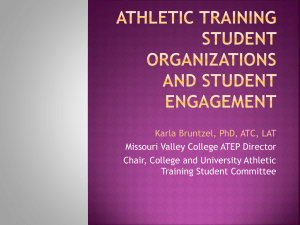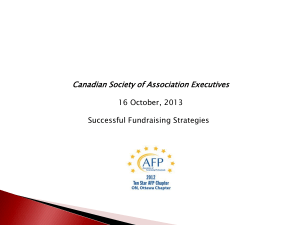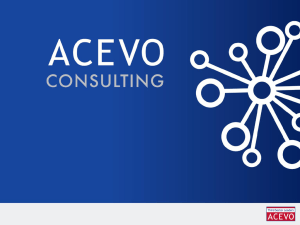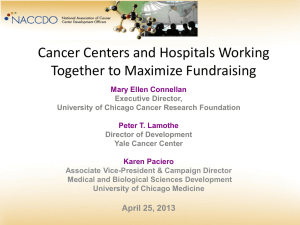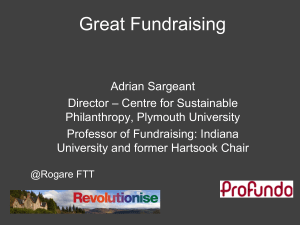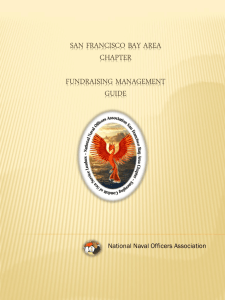Presentation Notes
advertisement
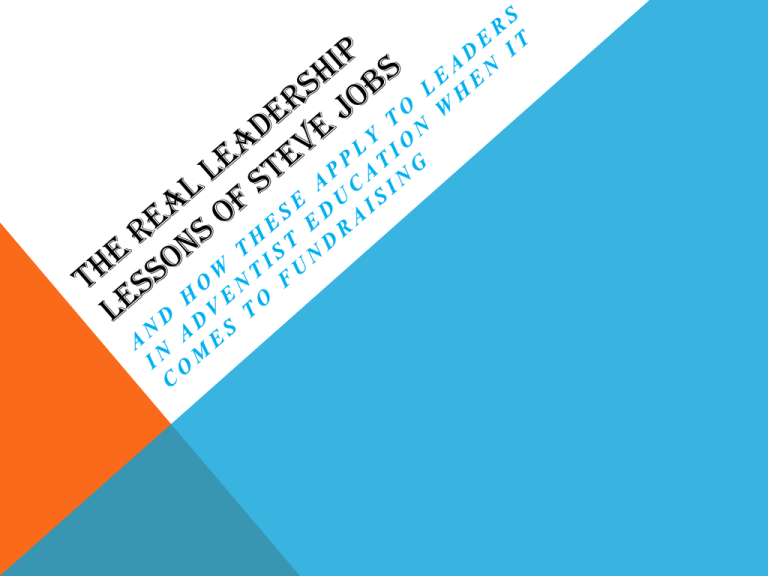
Dr. Lilya Wagner, CFRE Director Lilya.Wagner@nad.adventist.org Direct: 301-680-6130 Cell: 317-250-8274 www.philanthropicservice.com General phone line: 301-680-6131 General e-mail: info@philanthropicservice.com PRACTICES THAT EVERY CEO SHOULD EMULATE Adapted from a Harvard Business Review reprint, “The Real Leadership Lessons of Steve Jobs,” April 2012 Six months after Jobs’s death, the author of his best-selling biography identifies the practices that every CEO can try to emulate. by Walter Isaacson BACKGROUND Cofounded Apple in parents’ garage in 1976. Ousted in 1985. Rescued company from near bankruptcy in 1997. Died October 2011. Had built Apple into the world’s most valuable company. Helped transform seven industries: personal computing, animated movies, music, phones, tablet computing, retail stores, digital publishing. Belongs in pantheon of America’s great innovators. Lessons can be drawn from what he accomplished. The keys to his success can also be applied to Adventist education and the people who lead them—most importantly, the leaders’ involvement in fundraising for the multiple benefits of their institutions. FOCUS Focus on mission. Focus on great outcomes. Focus on what can best be done. Focus on priorities. Application to fundraising and the leader’s role: SIMPLIFY Zero in on the essence, eliminate unnecessary components. Simplicity comes from conquering, not just ignoring, complexity. “It takes a lot of hard work to make something simple, to truly understand the underlying challenges and come up with elegant solutions.” Application to fundraising and the leader’s role: TAKE RESPONSIBILITY END TO END Parts of the institution and its programs are linked together. Achieve delightful user experiences. Where does the buck stop? Application to fundraising and the leader’s role: WHEN BEHIND, LEAPFROG The mark of an innovative company is not only that it comes up with new ideas first. It also knows how to leapfrog when it finds itself behind. Instead of just catching up, transform! Application to fundraising and the leader’s role: PUT PRODUCTS BEFORE PROFITS Jobs never spoke of profit maximization or cost trade-offs. He focused on what the product did. Focus on making the product great and the products will follow. Application to fundraising and the leader’s role: DON’T BE A SLAVE TO FOCUS GROUPS Customers don’t know what they want until we show them. “If I’d asked customers what they wanted, they would have told me, ‘A faster horse!’” Caring deeply about what customers want is much different from continually asking them what they want. Intuition and instinct are important. Application to fundraising and the leader’s role: BEND REALITY Push people to do the impossible. Believe in performing extraordinary feats. “You did the impossible because you didn’t realize it was impossible.” Application to fundraising and the leader’s role: IMPUTE People form an opinion about a product on how it’s presented and packaged. People DO judge a book by its cover. Application to fundraising and the leader’s role: PUSH FOR PERFECTION Go back to the drawing board if something isn’t perfect. Don’t hesitate to revise, recreate, reinvent. “A great carpenter isn’t going to use lousy wood for the back of a cabinet, even though nobody’s going to see it.” Application to fundraising and the leader’s role: TOLERATE ONLY ‘A’ PLAYERS Jobs infused Apple employees with an abiding passion to create groundbreaking products and a belief that they could accomplish what seemed impossible. In spite of challenges, top players tend to stick around longer. Loyalty engenders a vibrant organization. Application to fundraising and the leader’s role: ENGAGE FACE-TO-FACE Jobs knew too well the potential of the digital world so he was believer in face-to-face meetings. Ideas can’t be developed by e-mail and iChat. People should get out of offices and mingle. Think instead of using slide presentations! Engage, instead of showing slides. Application to fundraising and the leader’s role: KNOW BOTH THE BIG PICTURE AND THE DETAILS Deal with both large and minuscule issues with passion. Some CEOs are great at vision, others know that the details are important. Have the ability and desire to envision overarching strategy while focusing on tiniest aspects of design. Application to fundraising and the leader’s role: COMBINE THE HUMANITIES WITH THE SCIENCES Both poetry and processors are important. Creativity can occur with the joining of humanities and sciences. Join the head and the heart! Application to fundraising and the leader’s role: STAY HUNGRY, STAY FOOLISH Don’t be satisfied—keep striving. Complement the business side with the artistic, nonconformist. Don’t be afraid of risks. Application to fundraising and the leader’s role: HOW DOES THIS RELATE TO FUNDRAISING? • Courtship: the organization is not yet born but exists only as an idea. • Infancy: there is much support and the organization is not expected to survive without help. • Go-Go Years: Market-driven times when the demand for services causes growth. • Adolescence: An organization begins to be concerned about its status and future. A time of turnover and upheaval, yet also a time for strengthening and reaffirming the mission. • Prime: Energy is high and a strong current of entrepreneurial behavior persists. • Maturity: This stage is characterized by stability. The goal is to sustain maturity. • Aristocracy: A feeling of self-satisfaction and inability to do wrong. Excesses may occur and communication breaks down. • Early Bureaucracy: A function of fear, inability to take responsibility for decisions, lack of trust and teamwork. • Bureaucracy (decay): The ultimate in negative attitudes such as fear, manipulation and distrust. • Death: A phase-out that is not deliberate. INDICATORS THAT AN ORGANIZATION HAS EMBRACED A CULTURE OF PHILANTHROPY • Everyone understands the need to raise money and is willing to do what is necessary to support the effort, regardless of role in the organization. • Everyone behaves as the organization’s ambassador, helping identify new friends and prospects whenever possible. • Everyone can articulate a case for giving and how the gift will be used. • Organizational processes are donor-centric. They are set up with the donor in mind, not just the staff. • Visitors are welcomed; dialogue is encouraged. The organization is highly responsive. • The CEO sees him/herself as the “face of the agency.” • The CEO is 100% committed and personally involved in fundraising. Recipients of the services of the organization are respected and viewed as experts in how the organization carries out its mission. The CEO, board, all personnel make financial contributions at least annually. - Adapted from OnCourse Consulting, “Embracing a Culture of Philanthropy: Why it matters” FUNDRAISING IS . . . The right person asking The right prospect For the right cause In the right way For the right amount At the right time From The Fund Raising School THE FUNDRAISING CYCLE Awareness of Marketing Principles Strategic Checkpoint: Demonstrate Stewardship and Renew the Gift Planning Checkpoint: Examine the Case Planning Checkpoint: Analyze Market Requirement Planning Checkpoint: Prepare Needs Statement Action Checkpoint: Solicit the Gift Planning Checkpoint: Define Objectives Action Checkpoint: Activate Volunteer Corps Planning Checkpoint: Prepare Communication Plan Action Checkpoint: Involve Volunteers Planning Checkpoint: Prepare Fundraising Plan Planning/Action Checkpoint: Validate Needs Statement Planning Checkpoint: Identify Potential Giving Sources Planning Checkpoint: Select Fundraising Vehicle Planning Checkpoint Evaluate Gift Markets Source: Adapted from Henry A. Rosso and Associates, Achieving Excellence in Fund Raising, 2nd edition, p. 24. Copyright © 2003 Jossey-Bass Inc., Publishers. Reprinted by permission of Jossey-Bass Inc., a subsidiary of John Wiley & Sons, Inc. QUESTIONS? ANSWERS? IDEAS? SUGGESTIONS? TIME IS UP!
